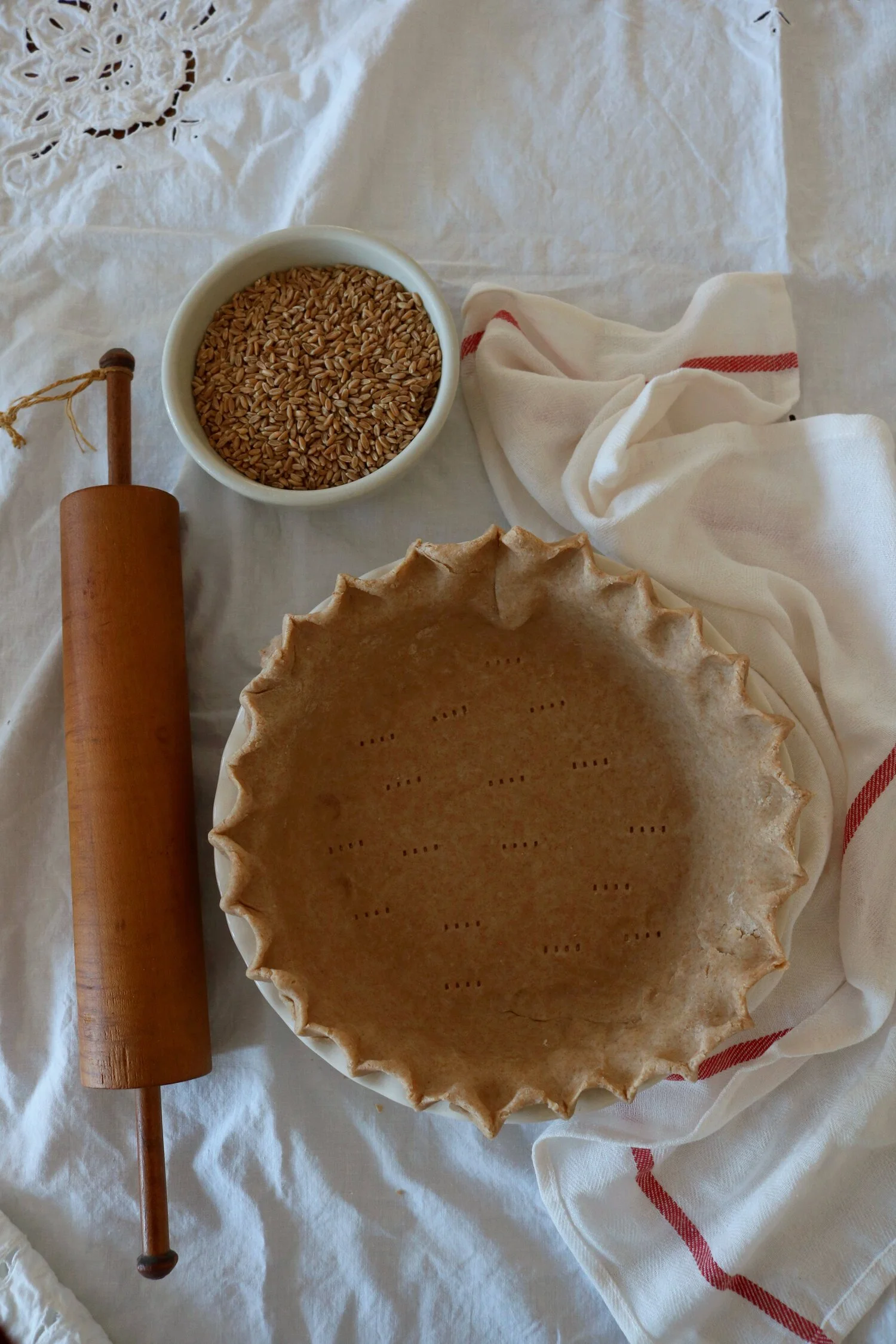Spelt Pie Crust
Spelt: the ancient grain I never knew that I needed. Wow, is it wonderful! I have spent the past month diving head first into milling and cooking with whole grain flours, and its been an absolute treat. We never realized how bland white flour was until this, and while I have cooked with store bought whole wheat before and attempted to make my own flours in a food processor… it was just not the same as using a mill, which is why I kind of stopped writing about it. I thought it wasn’t that great, but it was just because I didn’t have the correct tools.
I am lucky to live near a wonderful little bulk grocery store that sells a multitude of different grains. I have written about it before, Stringtown Grocery, that’s run by an Amish family within our community. When we first moved to town, I was blown away by the selection and what I assumed was all “homegrown” foods and ingredients. I’ve learned over the years that this isn’t necessarily the case, a lot of their food is imported just like any other grocery store, but there’s no other place local to me where I can find whole grains at such an awesome price and with such a diverse selection. While I would absolutely love if I could source local or organic grains (because I have no idea where these came from), I would make that choice, but this is where I am at. They do have a smaller selection of organically grown grains, though, if you live local to us and are in search of some for yourself!
Let’s talk a little about spelt…
Spelt is an ancient grain. It is closely related to the modern wheat that we ate today and is considered by many to be a type of wheat, much like einkorn. Because they share many of the same qualities, spelt does contain gluten and is therefore, not an option for gluten-free baking. It is not necessarily any better for you than wheat, I am sure to the surprise of many. I think it’s interesting how the term “ancient whole grains” can throw you off into thinking they are healthier or super-foods, when they scientifically are very similar. I am thankful to have a chemist for a husband because he often puts me in my place about trying to hype or dismantle certain foods. We spent well over an hour researching the chemical structure and process of making baking soda and whether it was truly good for your body or not… but I digress. The only thing different about spelt than wheat is that it has a little bit more protein and zinc in it.
Spelt has been grown and harvested since 5000 BC. It wasn’t until the industrial revolution that spelt had a decline in production and altogether disappeared from the marketplace. This was due to the hybridization of modern wheat, which was genetically modified to grow in a more efficient manner, harvested, and processed in a much more affordable manner.
What makes spelt any better than wheat? The structure of the gluten, for one! It is softer, more water soluble, which makes it easier for your stomach to digest. It has a nutty aroma and flavor. I have been using spelt in most of our cooking lately to get a better idea of how I like to use it. So far, we are extremely satisfied with the way it bakes up and makes our food taste. It has a really rich flavor, and it does make my pastry soft and flaky. I like it best, so far, used for pastry doughs like pie crust, and I recently used it to make biscuits which gave them a new depth of flavor. It also works well in rouxs for gravy!
ingredients & recipe:
1 1/2 cups spelt flour
1/2 cup all purpose flour
1 tbsp sugar
1/2 tsp salt
1/2 cup cold, cubed butter or lard (I use lard)
6-8 tbsp cold water
DIRECTIONS:
Mix together the spelt flour, all purpose flour, sugar, and salt.
Cut in the cold butter or lard with a pastry blender or fork. Try not to use your hands, as it will begin to melt the fat and create a rubbery pie crust.
Slowly begin to incorporate the cold water by tablespoonful until the dough forms a ball and no longer leaves behind dry crumbs.
Shape the dough into a disc and store wrapped in plastic wrap or beeswax wrap in the fridge for at least 1 hour and up to 2 days.
When ready to bake, remove from the fridge and roll out into a 10-12 inch circle. Place in your pie pan of choice and flute the edges. Pierce the bottom with the tines of a fork. Use as directed in your chosen pie recipe!
For more tips on baking a delicious pie crust, check out my blog post here!
I am currently eating dairy-free while breastfeeding Dean, as he is showing signs of a dairy protein allergy. I am making it more of a fun challenge for myself to see what I can make, and I’ve been having a lot of fun with it. In my dairy-free cooking experiments, I have fully converted from butter pie crusts to lard based ones. They truly are superior, at least when it comes to texture. They are easier to work with and mold, and I’ve noticed that with lard and using my own flours, they keep their shape when baking. When using butter, I am typically battling against a more rubbery crust that ends up collapsing while blind baking. With the spelt and lard, I can shape the edges, and they stay fluted after baking! While the delicious buttery flavor is missing, this is made up for in the flavoring of the filling.
Have you tried baking with spelt before?
xoxo Kayla







